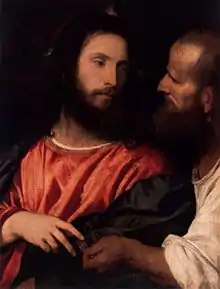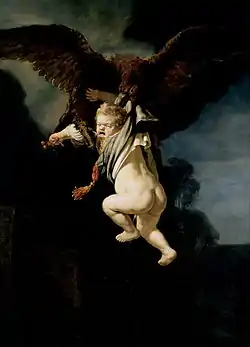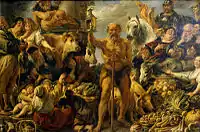Gemäldegalerie Alte Meister
The Gemäldegalerie Alte Meister (German pronunciation: [ɡəˈmɛːldəɡaləˌʁiː ˈʔaltə ˈmaɪstɐ], Old Masters Gallery) in Dresden, Germany, displays around 750 paintings from the 15th to the 18th centuries. It includes major Italian Renaissance works as well as Dutch and Flemish paintings. Outstanding works by German, French, and Spanish painters of the period are also among the gallery's attractions.
The Old Masters are part of the Dresden State Art Collections. The collection is located in the Semper Gallery, the gallery wing of the Zwinger.
History


When the Kunstkammer (Art Chamber) of the Electors of Saxony in Dresden was founded by Augustus, Elector of Saxony in 1560, paintings were subordinate to collectors' pieces from science, other art works and curiosities.[1] It was not until the beginning of the 18th century that Augustus II the Strong and his son Frederick Augustus II started to collect paintings systematically. Over a period of less than 60 years, these two art-loving Electors of Saxony, who were also Kings of Poland, expanded the collections significantly. In 1745, the 100 best pieces of the collection belonging to the Duke of Modena (Francesco III) were purchased, arriving in Dresden the following year.[1]
As the fast-growing painting collection soon required more space for storage and presentation, it was moved from Dresden Castle to the adjacent Stallgebäude (the Electors’ Stables Building) in 1747.[2]
In the meantime the collection had achieved European fame. Paintings from all over Europe, especially from Italy, Paris,[3] Amsterdam and Prague, were acquired and sent to Dresden. The purchasing activities of the Electors were crowned by the acquisition of Raphael’s Sistine Madonna in 1754.[1] The Dresden painting gallery became not only one of the most famous Old Masters collections in Northern European, but also a prototyp of the modern museums that would emergence in the late 18th century.[4]
In 1838, the architect Gottfried Semper was invited by a gallery commission working for King Frederick Augustus II, to design an appropriate architectural setting for the collection. The new gallery wing of the Zwinger was consequently built from 1847 to 1854. On 25 September 1855, the Neues Königliches Museum (New Royal Museum) opened in the Semper Gallery where it is still located today.[2]
Due to shortage of space in 1931,, the Modern Department of the museum with paintings from the 19th and 20th centuries moved into a separate building on Brühl's Terrace, laying the foundations for what is now known as the New Masters Gallery.
When World War II was imminent in 1938, the museum was closed. The artworks were mostly safely stored away when the gallery building itself was severely damaged in the bombing of Dresden on 13 February 1945. At the end of the war in 1945, most of the paintings were confiscated by the Red Army and transported to Moscow and Kiev. On their return to Dresden in 1955, part of the collection was displayed on the ground floor of the still partly destroyed Semper Gallery. The Old Masters Gallery re-opened in 1960 after the reconstruction of the gallery building was completed. While the most important paintings survived this period, the losses were significant. Records from 1963 state that 206 paintings had been destroyed and 507 were missing.[1] Of these, some 450 are still missing today.[1]
Collection

Some 750 paintings, or 40 percent of the entire collection, are exhibited in the gallery. They date from the 15th to the 18th centuries. Paintings from the 19th century onwards are displayed in the New Masters Gallery (Gemäldegalerie Neue Meister) in the Albertinum.
Renaissance and Baroque masterpieces by Italian painters such as Raphael, Titian, Giorgione, Correggio, Tintoretto and Guercino are displayed. The collection contains a large number of 17th-century Flemish and Dutch paintings by Rubens, Rembrandt, Jordaens, Van Dyck and Vermeer. Outstanding works by German, French and Spanish painters are also among the gallery's attractions.
With 58 paintings by Lucas Cranach the Elder and Lucas Cranach the Younger, the gallery houses the world's largest collection of Cranach paintings. Panels and canvases of the early Renaissance are also exhibited, including the recently restored Saint Sebastian by Antonello da Messina.
The color of the walls is used to structure the collection. Italian artwork is exhibited in rooms with deep red walls. Dutch and Flemish paintings are shown on green backgrounds. Spanish and French pictures from the 17th century are displayed on gray walls.
The Gemäldegalerie Alte Meister receives more than 500,000 visitors a year.
Highlights of the collection
 Raphael: Sistine Madonna, 1512
Raphael: Sistine Madonna, 1512 Correggio: Madonna and Child with St Francis, 1514-15
Correggio: Madonna and Child with St Francis, 1514-15 Giorgione: Sleeping Venus, 1508/10
Giorgione: Sleeping Venus, 1508/10 Vermeer: The Procuress, 1656
Vermeer: The Procuress, 1656 Jan van Eyck: Dresden Triptych, c. 1437
Jan van Eyck: Dresden Triptych, c. 1437 Titian: The Tribute Money, c. 1516
Titian: The Tribute Money, c. 1516 Jean-Étienne Liotard: The Chocolate Girl, 1744/45
Jean-Étienne Liotard: The Chocolate Girl, 1744/45

 Lucas Cranach the Elder: Eve, 1531
Lucas Cranach the Elder: Eve, 1531 Hans Holbein the Younger: Charles de Solier, comte de Morette, (1480/81-1564), 1534/35
Hans Holbein the Younger: Charles de Solier, comte de Morette, (1480/81-1564), 1534/35 Francisco Zurbarán: St. Bonaventure at Prayer, 1628/29
Francisco Zurbarán: St. Bonaventure at Prayer, 1628/29 Jusepe de Ribera: The Deliverance of St. Peter from Prison, 1642
Jusepe de Ribera: The Deliverance of St. Peter from Prison, 1642 Mattia Preti: The Deliverance of St. Peter from Prison, 1650
Mattia Preti: The Deliverance of St. Peter from Prison, 1650 Pinturicchio: Portrait of a Boy, c. 1500
Pinturicchio: Portrait of a Boy, c. 1500

 Peter Paul Rubens: Hercules Drunk, Being Led Away By a Nymph and a Satyr, c. 1613/14
Peter Paul Rubens: Hercules Drunk, Being Led Away By a Nymph and a Satyr, c. 1613/14 Anthony van Dyck: Portrait of a Commander in Armour, with a Red Scarf, c. 1625/27
Anthony van Dyck: Portrait of a Commander in Armour, with a Red Scarf, c. 1625/27
 Jacob Jordaens: Diogenes Searching for an Honest Man, c. 1642
Jacob Jordaens: Diogenes Searching for an Honest Man, c. 1642
Other
- The year 2012 marks the 500th anniversary of Raphael's Dresden masterpiece Sistine Madonna which was celebrated with a special exhibition.
- The paintings are moved from their current place in the western part of the building into the then renovated eastern part in January 2016. The visible collection will be reduced to approximately 400 pieces for this period. The renovation of the western part will be finished in 2017.[5]
See also
Notes and references
- Harald Marx: Gemäldegalerie Dresden - Führer Alte Meister . E. A. Seemann, Leipzig, 3. Aufl., 2006, ISBN 978-3-86502-021-5, pp. 8-17. (in German)
- Fritz Löffler: Das alte Dresden - Geschichte seiner Bauten. 16th ed. Leipzig: Seemann, 2006, ISBN 978-3-86502-000-0 (in German)
- Virginie Spenlé: Les achats de peintures d’Auguste III sur le marché de l’art parisien, in: Bulletin de la Société de l’Histoire de l’Art français 2002 (2003), pp. 93-134
- Virginie Spenlé: Von der Sammlung zum Museum: Die Dresdener Gemäldegalerie im Stallhof, Dresdener Kunstblätter 52 (2009), S. 59-64 (ISSN 0418-0615) (in German)
- „Sixtinische Madonna“ packt ihre Putten in: SZ-online, 23. November 2015
Further reading
- Virginie Spenlé: Die Dresdner Gemäldegalerie und Frankreich. Der „bon goût“ in Sachsen, Beucha: Sax-Verlag 2008 (ISBN 978-3-86729-028-9)
- A. H. Payne, Royal Dresden Gallery, New York: D. Appleton, OCLC 8988584, OL 24972025M
- Gemäldegalerie (Dresden, Germany) (1873), Complete catalogue of the Royal Picture Gallery at Dresden, Dresden, [Germany]: G. Schönfeld's Buchhandlung, OCLC 4424862, OL 14001467M
- Gemäldegalerie (Dresden, Germany) (1912), Catalogue of the pictures in the Royal Gallery at Dresden, Dresden: Buchdr. der Wilhelm und Bertha v. Baensch Stiftung, OCLC 4232437, OL 14007181M
External links
 Media related to Gemäldegalerie Alte Meister (Dresden) at Wikimedia Commons
Media related to Gemäldegalerie Alte Meister (Dresden) at Wikimedia Commons- Old Masters Picture Gallery of the Dresden State Art Collections
.jpg.webp)